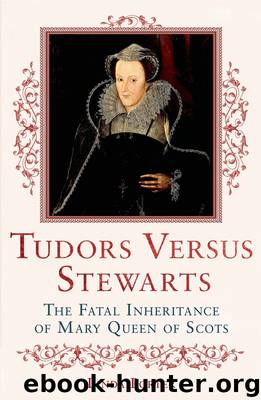Tudors Versus Stewarts by Linda Porter

Author:Linda Porter
Language: eng
Format: epub
ISBN: 9781466842724
Publisher: St. Martin's Press
CHAPTER TEN
Solway Moss
‘Finally mine espial sayeth that the said king will not make war against any other realm, but liveth in fear to defend his own, for the king’s nature, his disposition and his qualities are not given to war; but daily labouring in his mind covetously for profit.’
The report of an English spy on James V’s intentions, May 1542
THE VISITOR TO THE VILLAGE of Falkland in Fife is immediately struck by the sight of a fairy-tale Loire château in miniature. A typically French Renaissance exterior is matched by an elegant interior and lovely gardens. This distinctive residence, the courtyards of which have been described as ‘a display of early Renaissance architecture without parallel in the British Isles’, is grand yet still intimate. Given to Mary of Guise on her marriage to James V, it was well equipped for both leisure and more active pastimes such as hunting in the nearby countryside. The palace was also favoured by Mary’s daughter, Mary Queen of Scots, who would later scandalize her male courtiers by donning breeches to play tennis on what is now the oldest surviving tennis court in Europe.
Mary of Guise soon discovered that, while the climate of her new country might be less forgiving than the milder airs of the Loire, there was much to please in Scotland. French influence was everywhere and this gave her hope for the future. James made an effort to improve his ability to speak her language and to impress her with the magnificence of his court and building programme. Falkland was part of a major effort of restoration and improvement at the Scottish palaces. In the year 1539, more than sixty masons were employed at the palace each month, under the watchful eye of John Scrymgeour, the king’s principal master of works, who was a local man. But continental craftsmen were used as well: the sculptor of the statues for the chapel buttresses was Dutch and one of the plasterers was French.
The architectural programme of James V achieved a great deal in the fourteen years of his personal rule and encompassed all the leading residences. But it was at Stirling that James V’s vision of his dynasty and Scotland’s place in the European order was perhaps most fully realized. A new palace block was constructed, the features of which owed something to both Burgundian and French styles, and its interior was sophisticated and magnificent. James’s palace has been superbly renovated and is one of the finest examples of a sixteenth-century interior in Britain. Reopened in 2011, anyone who seeks to understand this king’s desire to leave his mark and hold his own with the great continental courts should go and see it. The ceilings are particularly fine, as are the tapestries, specially commissioned to match the originals which adorned the walls in the 1530s and 1540s. All of this would have been admired by the elite of Scottish society and politics, as well, of course, as the representatives of foreign powers waiting in the
Download
This site does not store any files on its server. We only index and link to content provided by other sites. Please contact the content providers to delete copyright contents if any and email us, we'll remove relevant links or contents immediately.
| Africa | Asia |
| Canadian | Europe |
| Holocaust | Latin America |
| Middle East | United States |
Fanny Burney by Claire Harman(25784)
Empire of the Sikhs by Patwant Singh(22172)
Out of India by Michael Foss(16312)
Leonardo da Vinci by Walter Isaacson(11901)
Small Great Things by Jodi Picoult(6093)
The Six Wives Of Henry VIII (WOMEN IN HISTORY) by Fraser Antonia(4790)
The Wind in My Hair by Masih Alinejad(4424)
The Lonely City by Olivia Laing(4120)
The Crown by Robert Lacey(4105)
A Higher Loyalty: Truth, Lies, and Leadership by James Comey(4032)
The Iron Duke by The Iron Duke(3639)
Millionaire: The Philanderer, Gambler, and Duelist Who Invented Modern Finance by Janet Gleeson(3569)
Sticky Fingers by Joe Hagan(3454)
Alive: The Story of the Andes Survivors by Piers Paul Read(3310)
Papillon (English) by Henri Charrière(3269)
Joan of Arc by Mary Gordon(3257)
Stalin by Stephen Kotkin(3084)
Aleister Crowley: The Biography by Tobias Churton(3019)
Ants Among Elephants by Sujatha Gidla(2924)
